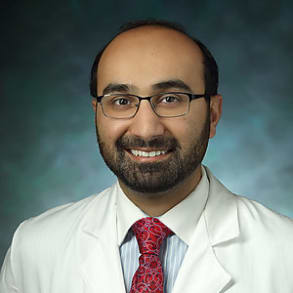Cardiac surgeon Hamza Aziz discusses the hybrid convergent procedure, which is used to treat longstanding and persistent atrial fibrillation. He provides details on this two-stage procedure and insight on the types of patients that benefit most, as well as alternative treatment options.
The conversion procedure is a two stage hybrid operation that includes a epicardial meaning outside of the heart and an endocardial procedure meaning inside of the heart. So two stage ablations in the first ablation, we make an incision about a three centimeter incision over the xiphoid process that allows us access to get behind the heart and be able to ablate the back wall of the heart where a lot of the um for atrial fibrillation come from. And once we're done with that, then we come over to the left side of the chest and are able to put a clip on the left atrial appendage where the vast majority of strokes come from in patients with atrial fibrillation. So this is a fairly minimally invasive procedure. Patients stay a day or two afterwards and are then discharged and are then followed up in electrophysiology about 4 to 6 weeks later for a endocardial ablation, meaning where they go in through the groin and are able to ablate any remaining areas that need to get touched up with a endocardial ablation probe. Following that patients are watched to see if they have any recurrence and what we've found is that this procedure has much better um outcomes compared to the standard management, which is a medications alone or even just an endocardial ablation alone. So, in a randomized control trial that was recently published, what we found was that patients who underwent the hybrid approach to long standing persistent atrial fibrillation, those patients in particular did better compared to catheter alone. And what we found was that patients who had undergone conversion procedures, their freedom from atrial fibrillation was higher. Uh both on and off anti arhythmic therapy, their overall burden of atrial fibrillation had reduced. And so overall, the outcomes from this procedure were better compared to the standard therapy that we currently offer patients. And the advantage is that with the additional gain in outcomes, we weren't necessarily making a major sternotomy. The approach is still fairly minimally invasive and that is an added benefit to this approach. So the ideal patient is someone who has long standing symptomatic persistent atrial fibrillation. Frequently patients have undergone prior therapy, either endocardial ablations or have been refractory to anti arrhythmic drugs and are still fairly symptomatic, meaning they're fairly fatigued, having shortness of breath with doing normal activity. And so those patients who are not finding symptomatic relief, those are the ideal patients that can be referred for this procedure. And, and we've had fairly good results. So far at Hopkins, we have a comprehensive team of electrophysiologists, cardiac surgeons and cardiologists that can provide a comprehensive, full spectrum of therapies for managing atrial fibrillation. Um ranging from medications to endocardial ablations, hybrid procedure and full biatrial open, you know, open biatrial maze. Um And so the full gamut can be, uh, is available and I think it's a one stop shop for patients looking to get treatment for their arrhythmias or atrial fibrillation.



